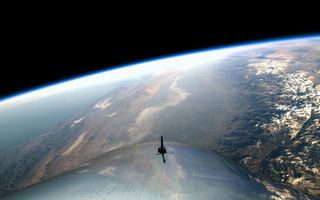
Virgin Galactic's next flight to suborbital space won't take place in the coming days after all.
The company will reschedule the third crewed test flight of its VSS Unity space plane, which had been targeted to take off from New Mexico's Spaceport America between Nov. 19 and Nov. 23, as a result of the surge of COVID-19 infections sweeping across the state, the nation and much of the world.
"With the health and safety of our team members in mind, and in accordance with the recent direction from the New Mexico Department of Health, we will be minimizing our New Mexico operations to the greatest degree possible," Virgin Galactic CEO Michael Colglazier said in a statement on Monday (Nov. 16).
Related: How Virgin Galactic's SpaceShipTwo works (infographic)
"While these new restrictions cause us to adjust our flight schedule, we take this pause in stride and will be prepared to resume our preflight procedures and announce a new test flight window as soon as we can," Colglazier said.
VSS Unity is Virgin Galactic's latest SpaceShipTwo vehicle, a six-passenger, two-pilot craft designed to make brief jaunts to suborbital space. SpaceShipTwo takes off from a runway beneath the wing of a carrier plane called WhiteKnightTwo. At an altitude of about 50,000 feet (15,000 meters), SpaceShipTwo drops free and makes its own way to suborbital space.
Unity has reached space twice to date, on test flights in December 2018 and February 2019. Both of those missions lifted off from Mojave Air and Space Port in southeastern California, near the headquarters of The Spaceship Company, Virgin Galactic's manufacturing subsidiary.
Get the Space.com Newsletter
Breaking space news, the latest updates on rocket launches, skywatching events and more!
The upcoming third spaceflight will be the first one Unity makes from Spaceport America, the hub of the company's commercial operations. It will be the first human spaceflight ever conducted from New Mexico, Colglazier said in an update earlier this month.
About 600 people have bought a ticket to ride SpaceShipTwo, at a price (most recently) of $250,000 per seat, Virgin Galactic representatives have said. The company paused ticket sales a while back but plans to reopen them next year, after Virgin Group founder Richard Branson flies aboard VSS Unity. (Branson has long said he wants to be on one of SpaceShipTwo's early spaceflights.)
The Spaceship Company is currently building two more SpaceShipTwo vehicles, and one of them is expected to roll out of the factory in early 2021, Virgin Galactic representatives have said. And more could come off the line in the relatively near future; the company's hangar at Spaceport America can hold up to five SpaceShipTwos and two WhiteKnightTwos simultaneously.
Virgin Galactic is also filling out its pilot corps. The company recently hired Jameel Janjua and Pat Moran, bringing the total number of Virgin Galactic pilots to eight.
Mike Wall is the author of "Out There" (Grand Central Publishing, 2018; illustrated by Karl Tate), a book about the search for alien life. Follow him on Twitter @michaeldwall. Follow us on Twitter @Spacedotcom or Facebook.
Join our Space Forums to keep talking space on the latest missions, night sky and more! And if you have a news tip, correction or comment, let us know at: community@space.com.

Michael Wall is a Senior Space Writer with Space.com and joined the team in 2010. He primarily covers exoplanets, spaceflight and military space, but has been known to dabble in the space art beat. His book about the search for alien life, "Out There," was published on Nov. 13, 2018. Before becoming a science writer, Michael worked as a herpetologist and wildlife biologist. He has a Ph.D. in evolutionary biology from the University of Sydney, Australia, a bachelor's degree from the University of Arizona, and a graduate certificate in science writing from the University of California, Santa Cruz. To find out what his latest project is, you can follow Michael on Twitter.